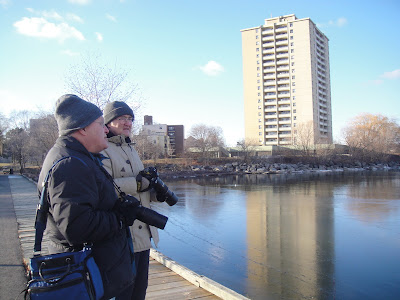We begin 2011 with a celebration of the commonplace. Eileen and I took a cold day in January to drive down to J.C. Saddington Park, on the shores of Lake Ontario near our home in Mississauga, so that I could try out my latest iPhone app. This was Geotagger, which allows you, with a bit of prestidigitation, to map the locations of your photographs.
It actually worked (unfortunately, Blogger does not seem to have the ability to display geotagging results for each photo,so you'll have to take my word on that), and in the meantime we passed a pleasant, if chilly, hour or so photographing ducks.
It actually worked (unfortunately, Blogger does not seem to have the ability to display geotagging results for each photo,so you'll have to take my word on that), and in the meantime we passed a pleasant, if chilly, hour or so photographing ducks.
The Lake Ontario waterfront in and near Toronto us a great place to find diving ducks in winter, but, numerous as they are, they don't always come in close to shore.
For close-range photography of ducks standing about on the frozen shore ice, we had to make do with Mallards (Anas platyrhynchos), the most commonplace if the puddleducks.
For close-range photography of ducks standing about on the frozen shore ice, we had to make do with Mallards (Anas platyrhynchos), the most commonplace if the puddleducks.
Mallards, as everyday as they are, are still beautiful things, and the males are among the most colourful of all ducks.
The white breast on this male is a sign that this bird is probably a genetic mixture between wild Mallards and their barnyard descendants.
This is, more or less, an American Black Duck (Anas rubripes). I say "more or less" because the Black Duck hybridizes with Mallards, and in our corner of Ontario finding a purebred Black Duck can be tricky (if not impossible). The white tail feathers of this bird are probably an expression of Mallard, rather than Black Duck, genes.
From puddleducks to swans: There were two species of swan at the park, both there as the result of human activity - but for very different reasons. The bird at the top is a Mute Swan (Cygnus olor), the common ornamental species of Europe, introduced to North America in the 19th century. The other bird is a Trumpeter Swan (Cygnus buccinator), a North American species once reduced by overhunting to the brink of extinction. The birds along the Lake Ontario waterfront are the progeny of a successful reintroduction programme.
This difference means that Mute Swans, lovely as they are, come into the undesirable alien category - though some argue that they may once have been native themselves, on the basis of subfossil bones and a 1595 engraving that suggests that at least some birds were here before Europeans arrived. Whether any of the Mute Swans currently in North America are descendants of native birds (as opposed to European birds brought in in the late 1800s) is anyone's guess.
Trumpeter Swans are another matter. When I was a boy this was a species spoken of in the same breath as the Whooping Crane and the California Condor. In 1935 (some years before I was a boy, I hasten to add) only 69 birds were known to exist. Well, conservation sometimes works (as does discovery; some 2000 breeding birds turned up in Alaska in the 1960s): a survey in 2005 counted 34,803 trumpeters across North America, an increase of over 11,000 since even the previous census in 2000.
Trumpeters in the Greater Toronto area often carry yellow wing tags, used for Ontario-bred birds as part of a system of marking and tracking swans in both the US (where collars are used instead of tags) and Canada.
I wasn't the only photographer braving the cold -- proof that even the commonest birds (and the right equipment) can draw people (or, at least, fanatics) out -- at least on a sunny day!
From puddleducks to swans: There were two species of swan at the park, both there as the result of human activity - but for very different reasons. The bird at the top is a Mute Swan (Cygnus olor), the common ornamental species of Europe, introduced to North America in the 19th century. The other bird is a Trumpeter Swan (Cygnus buccinator), a North American species once reduced by overhunting to the brink of extinction. The birds along the Lake Ontario waterfront are the progeny of a successful reintroduction programme.
This difference means that Mute Swans, lovely as they are, come into the undesirable alien category - though some argue that they may once have been native themselves, on the basis of subfossil bones and a 1595 engraving that suggests that at least some birds were here before Europeans arrived. Whether any of the Mute Swans currently in North America are descendants of native birds (as opposed to European birds brought in in the late 1800s) is anyone's guess.
Trumpeter Swans are another matter. When I was a boy this was a species spoken of in the same breath as the Whooping Crane and the California Condor. In 1935 (some years before I was a boy, I hasten to add) only 69 birds were known to exist. Well, conservation sometimes works (as does discovery; some 2000 breeding birds turned up in Alaska in the 1960s): a survey in 2005 counted 34,803 trumpeters across North America, an increase of over 11,000 since even the previous census in 2000.
Trumpeters in the Greater Toronto area often carry yellow wing tags, used for Ontario-bred birds as part of a system of marking and tracking swans in both the US (where collars are used instead of tags) and Canada.
I wasn't the only photographer braving the cold -- proof that even the commonest birds (and the right equipment) can draw people (or, at least, fanatics) out -- at least on a sunny day!







































































